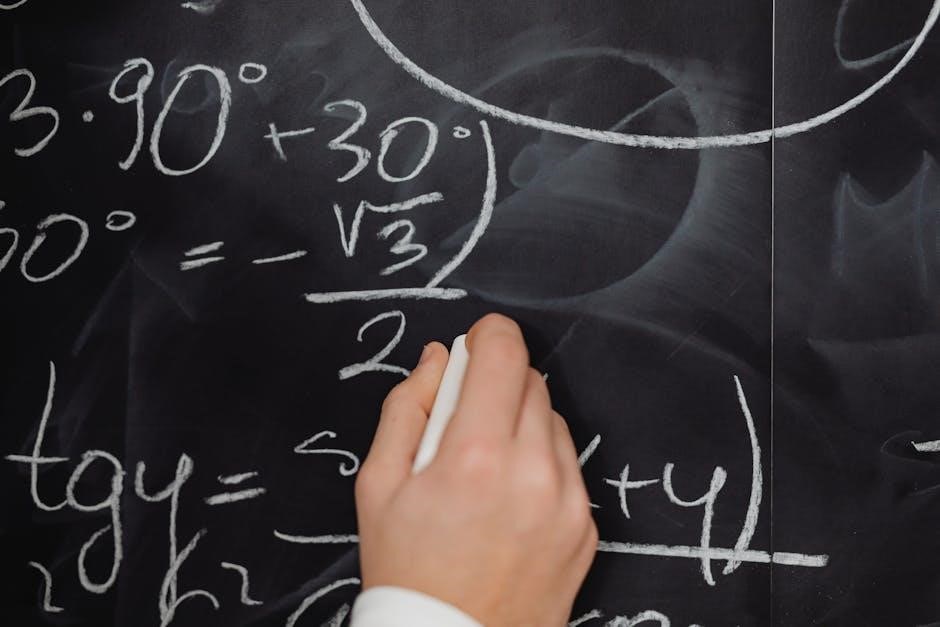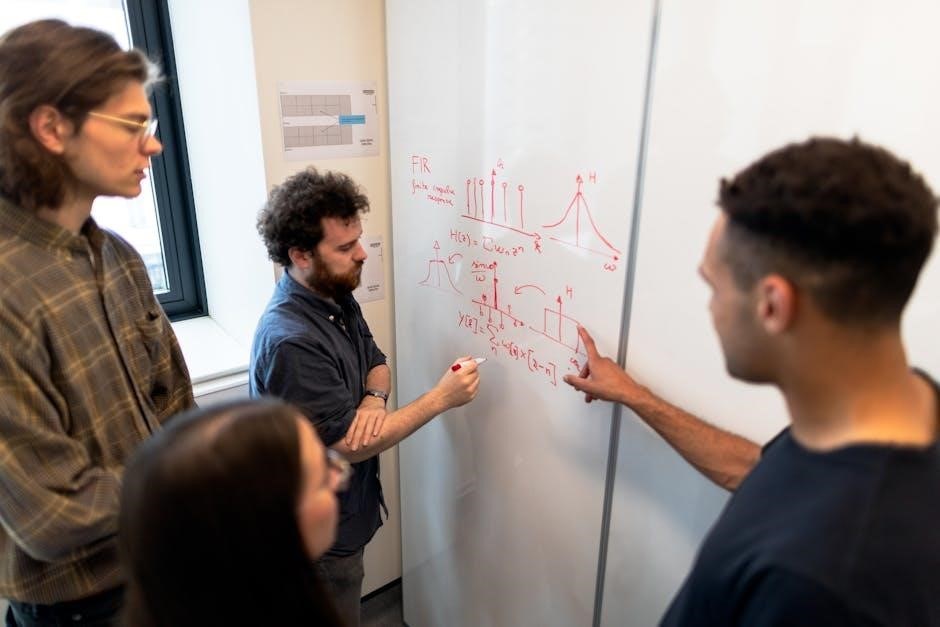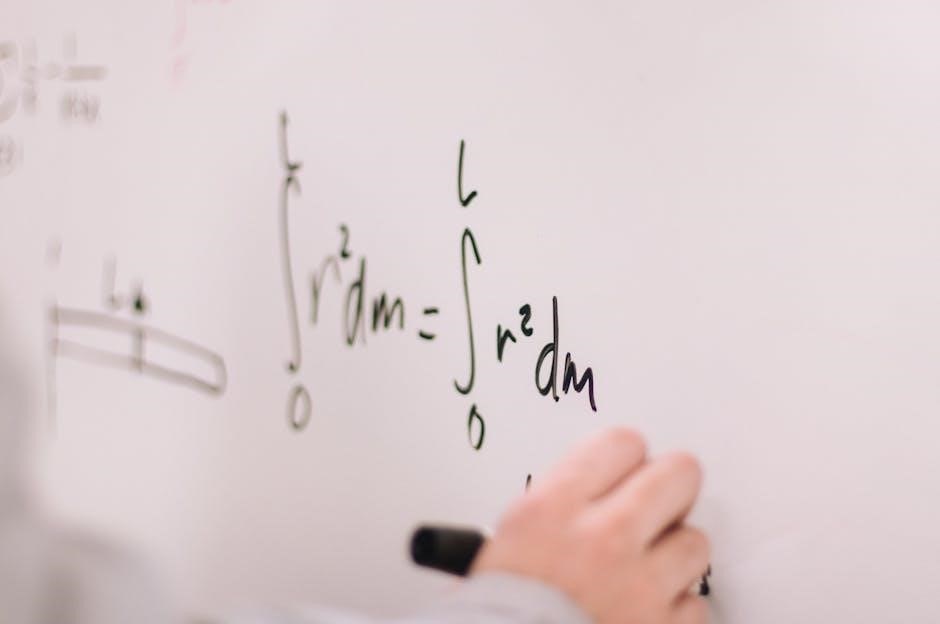physics principles and problems pdf
Welcome to the study of physics, where fundamental principles and problem-solving techniques are explored. This guide provides a comprehensive approach to understanding key concepts, from motion and energy to modern physics applications. Designed for students, it includes practical exercises, real-world examples, and resources for mastering physics effectively.
Fundamental Concepts in Physics
Understanding fundamental concepts in physics is essential for building a strong foundation. These include motion, forces, energy, and matter, which form the basis of physical laws and theories. Key areas like measurement, mathematics, and scientific methods are introduced to develop analytical skills; Concepts such as position, time, and velocity are explored to describe motion accurately. Energy types and interactions are explained to understand system dynamics. These principles, supported by practical problems and examples, help students grasp the underlying logic of physics and its applications in real-world scenarios.
Importance of Physics in Everyday Life
Physics plays a vital role in everyday life, influencing technology, transportation, and energy use. Principles like motion and forces are crucial in designing vehicles and machinery. Understanding energy conservation aids in developing sustainable solutions. Physics also underpins medical imaging technologies and communication devices. From smartphones to home appliances, physics drives innovation. Its applications in engineering and materials science improve infrastructure and safety. By studying physics, we gain insights into the natural world, enabling advancements that enhance daily life and address global challenges, making it an indispensable field for modern society.
Brief History of Physics Development
Physics has evolved significantly over centuries, from ancient philosophers like Aristotle to modern theorists. Key milestones include Newton’s laws of motion and gravitation, which laid the foundation for classical mechanics. The 19th century saw advancements in electromagnetism and thermodynamics, while the 20th century introduced relativity and quantum mechanics. These discoveries, driven by scientists like Einstein and Planck, revolutionized our understanding of the universe. Today, physics continues to advance, shaping technologies and addressing global challenges, making it a cornerstone of scientific progress and innovation across generations.
Core Principles of Physics
Physics is built on fundamental laws like motion, energy conservation, and gravitation. These principles form the foundation for understanding natural phenomena and solving complex problems in science.
Laws of Motion
The laws of motion, formulated by Sir Isaac Newton, describe how objects move and respond to forces. The first law introduces inertia, where objects maintain their state unless acted upon by an external force. The second law relates force, mass, and acceleration, expressed as F = ma. The third law states that every action has an equal and opposite reaction. These principles are fundamental in understanding dynamics and solving problems involving motion. They apply universally, from everyday objects to celestial bodies, making them cornerstone concepts in physics.
Conservation of Energy
The conservation of energy states that energy cannot be created or destroyed, only transformed from one form to another. This principle applies universally, from simple mechanical systems to complex biological processes. For example, when a moving object slows down, its kinetic energy converts into thermal energy. Understanding this law is crucial for solving problems involving energy transfer and efficiency. It also underscores the interconnectedness of different energy forms, such as electrical, chemical, and nuclear, making it a cornerstone of physics and everyday applications.
Newton’s Laws of Gravitation
Newton’s law of gravitation explains the force of attraction between two masses; It states that every particle in the universe attracts every other particle with a force proportional to the product of their masses and inversely proportional to the square of the distance between them. The formula is ( F = G rac{m_1 m_2}{r^2} ), where ( G ) is the gravitational constant. This law applies universally, from the motion of planets to the fall of objects on Earth, making it a fundamental principle in understanding celestial mechanics and the behavior of matter.

Mechanics and Motion
Mechanics and Motion explores the fundamental principles governing physical systems. It covers forces, energy, and types of motion, providing a foundation for understanding natural phenomena.
Kinematics: Study of Motion
Kinematics is the branch of mechanics that describes motion without considering forces. It involves analyzing position, velocity, and acceleration over time. Key concepts include position-time graphs, which show how an object’s position changes, and velocity-time graphs, which illustrate acceleration. Problems often involve constant acceleration, such as a train starting from rest. Equations like (v = v_0 + at) and (s = ut + rac{1}{2}at^2) are essential tools. Mastering kinematics provides a foundation for understanding more complex physics principles and solving real-world motion problems effectively.
Dynamics: Forces and Motion
Dynamics explores the relationship between forces and motion, building on kinematics by introducing Newton’s laws. It examines how forces cause changes in motion, with key concepts like force, mass, and acceleration. Problems often involve calculating forces in equilibrium or under acceleration. For example, a train starting from rest illustrates how force leads to acceleration. Understanding dynamics is crucial for analyzing real-world systems, from simple collisions to complex mechanical designs, and is a cornerstone of physics problem-solving in various engineering and scientific applications.
Types of Motion: Translational and Rotational

Physics distinguishes between translational and rotational motion. Translational motion involves movement from one point to another, like a train accelerating uniformly. Rotational motion involves spinning around an axis, such as a turning wheel. Both types are fundamental in understanding how objects move and interact. Problems often involve calculating distances, speeds, or angular velocities. For example, a train starting from rest illustrates translational motion, while a spinning top demonstrates rotation. Mastering these concepts is essential for solving real-world physics problems and understanding mechanical systems in various applications.
Thermodynamics and States of Matter
Thermodynamics explores energy, heat, and phase changes. States of matter—solid, liquid, gas—depend on energy and structure. Understanding thermal properties aids in solving problems involving heat transfer and material behavior.
Basic Concepts of Thermodynamics

Thermodynamics examines the relationships between heat, work, and energy. It involves systems and their surroundings, focusing on energy transfer and transformation. Key concepts include internal energy, entropy, and the laws of thermodynamics. The first law highlights energy conservation, while the second introduces entropy, a measure of disorder. Understanding these principles is crucial for analyzing processes like phase changes and heat transfer. Practical applications range from engine efficiency to material property analysis, making thermodynamics essential in both theoretical and applied physics studies.
Phase Changes and States of Matter
Phase changes involve transitions between solid, liquid, and gas states, driven by energy exchange. These processes, such as melting, vaporization, and condensation, occur at specific temperatures and pressures. Understanding latent heat and heat capacity is crucial for analyzing these transitions. The states of matter are characterized by molecular arrangement and motion, with thermodynamic properties like temperature and pressure influencing their behavior. Studying phase changes and states of matter is essential for grasping thermal systems and material properties, with applications in engineering and everyday phenomena.
Thermal Properties of Materials
Thermal properties of materials describe how they respond to temperature changes. Key properties include specific heat capacity, thermal conductivity, and thermal expansion. Specific heat capacity is the energy required to change a material’s temperature, while thermal conductivity measures heat transfer efficiency. Materials expand or contract with temperature changes, affecting their dimensions and structural integrity. Understanding these properties is crucial for engineering applications, such as designing cooling systems or selecting appropriate construction materials; Variations in thermal properties among metals, insulators, and other substances influence their suitability for different technological uses.
Waves and Optics
Waves and optics explore the behavior of light and sound. Topics include wave types, interference, diffraction, and electromagnetic principles. Understanding these concepts is essential for optical technologies and applications.
Types of Waves: Mechanical and Electromagnetic
Waves are disturbances that transfer energy through a medium or space. Mechanical waves, like sound or water waves, require a physical medium to propagate. They include transverse and longitudinal waves, with examples such as light waves. Electromagnetic waves, such as light and radio waves, do not need a medium and can travel through a vacuum. Both types exhibit properties like frequency, wavelength, and speed, governed by specific physical laws. Understanding these wave types is crucial for applications in technology, communication, and optics.
Wave Behavior: Interference and Diffraction
Wave interference occurs when two or more waves interact, resulting in a new wave pattern. This can create constructive or destructive interference, depending on their phase alignment. Diffraction, on the other hand, is the bending of waves around obstacles or through openings. Both phenomena are fundamental to understanding wave behavior and are crucial in applications like sound, light, and telecommunications. These principles explain how waves propagate and interact in complex environments, showcasing the intricate nature of wave dynamics and their practical implications in various fields of physics and engineering.
Principles of Light and Optics
Light and optics explore the behavior of light, including reflection, refraction, and diffraction. Key principles involve the laws of reflection and Snell’s law for refraction. Lenses and mirrors are fundamental optical elements used in devices like microscopes and telescopes. Understanding light’s properties, such as polarization and interference, is crucial for modern technologies like fiber optics and lasers. These principles also explain natural phenomena, such as rainbows and mirages, highlighting the importance of light in both practical applications and theoretical physics.
Electricity and Magnetism
Electricity and magnetism form the foundation of electromagnetic phenomena. This section explores electric forces, fields, circuits, and magnetic induction, essential for understanding modern technological applications.
Electric Forces and Fields
Electric forces and fields are fundamental to understanding electromagnetic interactions. Electric fields are created by charged particles and exert forces on other charges. Coulomb’s Law describes the force between two point charges, while electric field lines visualize field strength and direction. Conductors and insulators respond differently to electric fields. Practical applications include capacitors, batteries, and electric motors. This section provides problem-solving strategies and examples to master these concepts, essential for advanced topics in physics and engineering.
Electric Circuits and Components
Electric circuits involve the flow of electric current through various components like resistors, capacitors, and inductors. Understanding circuit analysis is crucial for designing and troubleshooting electrical systems. Key concepts include Ohm’s Law, Kirchhoff’s Laws, and power dissipation. Series and parallel circuits demonstrate how components interact. Practical problems often involve calculating voltage, current, and resistance. This section provides detailed solutions and strategies for mastering circuit analysis, ensuring a solid foundation for advanced topics in electronics and engineering.
Magnetic Fields and Induction
Magnetic fields are generated by moving charges or changing electric fields. Understanding field lines, flux, and forces is essential. Faraday’s Law of Induction explains how changing magnetic fields produce electric currents. Lenz’s Law describes the direction of induced currents. Practical problems involve calculating induced EMF and eddy currents. This section provides solutions to common induction problems, emphasizing graphical and analytical methods. Mastering these concepts is vital for understanding generators, motors, and transformers, which are fundamental to modern technology and engineering applications.

Modern Physics
Modern physics explores relativity, quantum mechanics, and nuclear interactions. It introduces wave-particle duality, Schrödinger’s equation, and particle physics. Problem-solving techniques address advanced concepts like atomic structure and radiation.
Relativity: Special and General
Special relativity, introduced by Einstein, explores how time, space, and gravity are relative, especially at high speeds. General relativity explains gravity as spacetime curvature caused by mass and energy. Together, these theories revolutionized our understanding of the universe, from black holes to cosmic expansion. Problem-solving in relativity involves complex mathematical models and thought experiments. Resources like textbooks and online tutorials provide detailed explanations and practice problems to master these concepts. Understanding relativity is crucial for advancing in modern physics and tackling real-world phenomena.
Quantum Mechanics Basics
Quantum mechanics explores the behavior of matter and energy at atomic and subatomic levels. Key principles include wave-particle duality, uncertainty, and quantization. It explains phenomena like superposition and entanglement, challenging classical physics. Problem-solving involves Schrödinger’s equation and probabilistic interpretations. Resources such as textbooks and online tutorials provide detailed explanations and practice problems. Mastering quantum mechanics is essential for understanding modern technologies and theoretical advancements in physics. This section focuses on foundational concepts and their practical applications, preparing students for deeper exploration of quantum systems and their complexities.
Nuclear Physics and Radioactivity
Nuclear physics examines the structure and behavior of atomic nuclei, including protons, neutrons, and nuclear forces. Radioactivity involves the emission of particles like alpha, beta, and gamma rays from unstable nuclei. Key concepts include binding energy, nuclear reactions, and fission/fusion processes. Problem-solving in this area often involves calculating decay rates and energy releases. Resources like textbooks and online guides provide detailed explanations and practice problems. Understanding nuclear physics is crucial for applications in energy, medicine, and materials science, making it a vital area of study in modern physics.

Problem-Solving in Physics
Mastering physics requires effective problem-solving strategies. Practice problems and solutions manuals, like Glencoe Physics Principles and Problems, provide essential tools for understanding and applying key concepts.
Strategies for Solving Physics Problems
Effective problem-solving in physics involves identifying knowns and unknowns, visualizing scenarios, and applying relevant formulas. Start by understanding the problem deeply, then break it into manageable parts. Drawing diagrams and using graphs can simplify complex situations. Always verify units and dimensions to ensure consistency. Practice regularly to build intuition and master fundamental concepts. Reviewing mistakes and learning from them is crucial for improvement. Utilize study guides and solution manuals, like those in Glencoe Physics Principles and Problems, to refine your approach and gain confidence in tackling various types of problems.
Common Types of Physics Problems
Physics problems often involve motion, forces, energy, and thermodynamics. Kinematics problems focus on motion, velocity, and acceleration. Dynamics problems involve forces and Newton’s laws. Energy problems explore conservation and transformation. Thermal problems address heat transfer and phase changes. Wave problems deal with interference and diffraction. Electromagnetic problems involve circuits and fields. Each type requires a structured approach, starting with identifying knowns and unknowns, visualizing the scenario, and applying relevant formulas. Regular practice with these problem types builds problem-solving skills and deepens understanding of physics principles.
Using Formulas and Equations Effectively
Mastering the use of formulas and equations is essential for solving physics problems. Start by understanding the underlying concepts and identifying the knowns and unknowns. Select the most appropriate formula for the scenario, ensuring units are consistent. Plug in the values carefully, and perform calculations step-by-step. Verify the reasonableness of the result by checking its magnitude and unit. Common mistakes include incorrect substitutions and formula misapplication. Regular practice and reviewing derivations help build confidence and accuracy in using physics equations effectively.

Resources for Learning Physics
Explore recommended textbooks like Glencoe Physics: Principles & Problems and online resources for interactive learning. Utilize practice problems, video tutorials, and study guides to enhance understanding and problem-solving skills.
Recommended Textbooks and PDFs
For a comprehensive understanding, consider Glencoe Physics: Principles & Problems, a widely acclaimed textbook offering detailed explanations and practice exercises. Additionally, the Physics Principles and Problems Chapter 2 Assessment PDF provides valuable problem sets for self-study. These resources are designed to align with curriculum standards, ensuring a thorough grasp of fundamental concepts and their practical applications. They are ideal for students seeking to reinforce their knowledge and improve problem-solving skills in physics.
Online Resources and Tutorials
Enhance your learning with online resources like YouTube, offering video tutorials on physics principles and problem-solving techniques. Platforms such as Brilliant.org provide interactive lessons and exercises to deepen your understanding. Additionally, downloadable PDFs like the Glencoe Physics: Principles & Problems textbook and chapter assessments are available for self-study. These resources are designed to complement traditional learning, making complex concepts more accessible and engaging. Utilize these tools to explore topics at your own pace and reinforce your knowledge of physics fundamentals.
Practice Problems and Solutions
Master physics concepts with practice problems and solutions tailored to your learning needs. The Glencoe Physics: Principles & Problems textbook offers a wide range of exercises, from basic to advanced, covering topics like motion, energy, and modern physics. Chapter assessments and solution manuals provide detailed answers, helping you understand problem-solving strategies. These resources are designed to reinforce your understanding of key principles and prepare you for exams. Regular practice with these problems will enhance your ability to apply physics concepts to real-world scenarios effectively.
Assessments and Evaluations
Assessments in physics principles and problems pdf include chapter tests, quizzes, and final exams. These evaluations measure understanding of concepts like motion, energy, and modern physics, ensuring readiness for advanced studies.
Types of Physics Assessments
Physics assessments vary, including chapter tests, quizzes, and comprehensive exams. These evaluations align with textbook chapters, ensuring mastery of concepts like motion, energy, and modern physics. Problem-solving exercises and multiple-choice questions test analytical and theoretical understanding. Practical lab assessments may also be included to evaluate experimental skills. Additionally, online resources offer practice tests, such as the Chapter 2 Assessment PDF, to help students prepare. These tools provide immediate feedback, reinforcing learning and identifying areas for improvement. Regular assessments ensure a strong foundation in physics principles and problem-solving techniques.
Preparing for Physics Exams
Effective exam preparation involves mastering key concepts and practicing problem-solving techniques. Review study guides, such as the Glencoe Physics Principles and Problems PDF, to understand fundamental principles. Focus on understanding equations and their applications; Utilize online resources, including video tutorials and practice tests, to reinforce learning. Allocate time for each topic, ensuring a balanced study plan. Regularly review notes and past papers to identify weak areas. Engage with interactive tools, like the Chapter 2 Assessment, to test knowledge. Consistent practice and seeking help when needed are crucial for success in physics exams.
Understanding Assessment Results
Assessment results provide valuable insights into your grasp of physics principles. Review your scores to identify strengths and areas needing improvement. Focus on questions where errors occurred, analyzing incorrect approaches. Utilize solutions manuals, like the Glencoe Physics Principles and Problems PDF, to understand correct methods. Reflect on common mistakes and revise relevant topics. Track progress over time to monitor improvement. Use assessment feedback to refine study strategies, ensuring a deeper understanding of key concepts and problem-solving techniques. This iterative process enhances learning and prepares you for future challenges in physics.

Study Guides and Supplements
Enhance your physics learning with study guides and supplements like the Glencoe Physics Principles and Problems PDF. These resources offer detailed explanations, practice problems, and solutions to deepen understanding and improve problem-solving skills. Utilize supplementary materials to reinforce concepts and prepare for assessments effectively.
Using Study Guides Effectively
To maximize learning, use study guides like the Glencoe Physics Principles and Problems PDF strategically. Start by setting clear goals and focusing on weak areas. Engage actively by solving problems and reviewing solutions to understand concepts deeply. Utilize the structured format to organize your study schedule and track progress. Regularly review key formulas and concepts to build a strong foundation. Supplement textbook learning with additional resources for a comprehensive understanding. By following these steps, you can enhance your problem-solving skills and excel in physics.
Supplementary Materials for Physics

Supplement your physics learning with resources like the Glencoe Physics Principles and Problems PDF, which offers detailed solutions and practice problems. Utilize online tutorials, video lectures, and interactive simulations to visualize complex concepts. Additionally, study guides and workbooks provide structured exercises to reinforce understanding. Leverage digital tools, such as physics apps and educational websites, for hands-on practice. These materials complement traditional textbooks, offering diverse learning opportunities and helping you master key principles and problem-solving techniques effectively.
Tips for Self-Study in Physics
For effective self-study in physics, set clear goals and create a structured schedule. Start with foundational concepts, using resources like the Physics Principles and Problems PDF for guided learning. Watch video lectures and tutorials to visualize complex ideas. Regularly practice problems, focusing on understanding rather than just solving; Review mistakes to identify weak areas. Engage with online forums or study groups for clarification. Use flashcards for key formulas and concepts. Stay consistent, and gradually increase difficulty as confidence grows. Combine theoretical learning with practical applications to deepen understanding and retention.

The Role of Practice in Physics
Regular practice is essential for mastering physics principles. Use problem sets from resources like the Physics Principles and Problems PDF to reinforce concepts and develop problem-solving skills consistently.
Importance of Regular Practice
Regular practice is crucial for mastering physics principles. It helps build problem-solving skills, reinforces key concepts, and improves the ability to apply formulas effectively. Consistent practice allows students to identify weak areas and strengthen their understanding. Using resources like the Physics Principles and Problems PDF and solving practice problems regularly enhances critical thinking and prepares students for various assessment types. Over time, regular practice fosters confidence and fluency in tackling complex physics challenges, making it an essential part of successful learning.
Effective Practice Techniques
Effective practice involves focusing on understanding concepts rather than just solving problems. Start with basic problems to build a strong foundation, then gradually tackle more complex scenarios. Use resources like the Physics Principles and Problems PDF to access a variety of exercises. Flashcards can help memorize key formulas and definitions. Regularly review mistakes to avoid repeating them. Practice actively by explaining concepts aloud or teaching them to others. Consistency and targeted focus ensure steady progress and mastery of physics principles over time.
Overcoming Challenges in Physics
Overcoming challenges in physics requires a systematic approach. Break complex problems into smaller, manageable steps and focus on understanding underlying principles. Regular practice with resources like the Physics Principles and Problems PDF helps build confidence. Visualize concepts using diagrams and graphs to enhance understanding. Review mistakes thoroughly to identify and correct weaknesses. Seek guidance from supplementary materials or instructors when stuck. Consistency and persistence are key to mastering difficult topics. Embrace challenges as opportunities to deepen your understanding and improve problem-solving skills.

